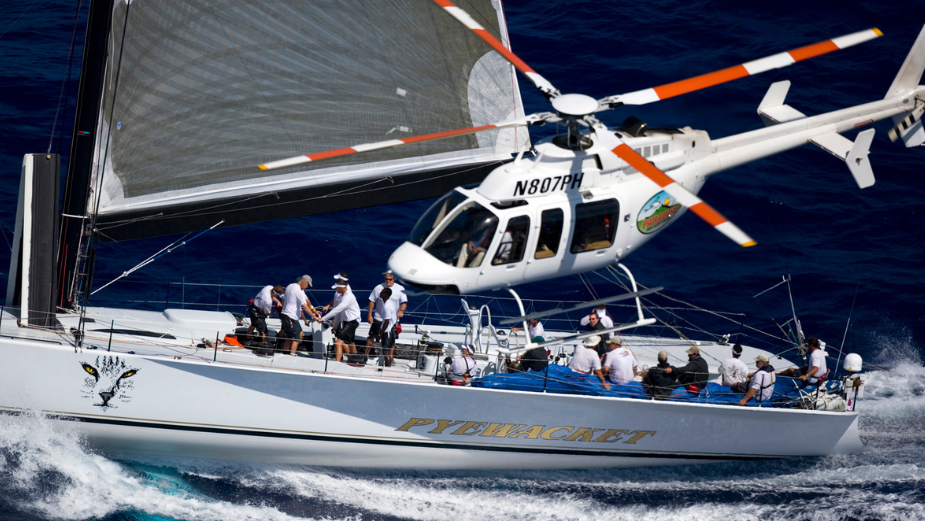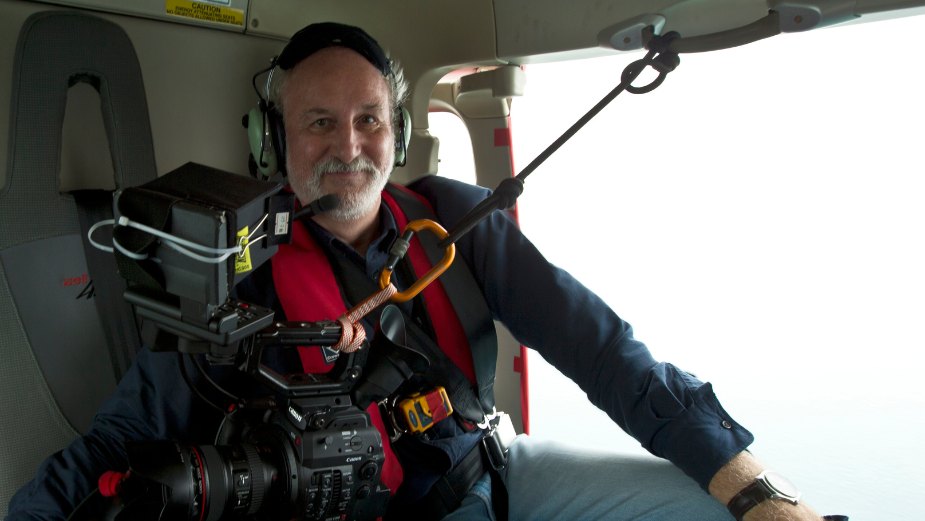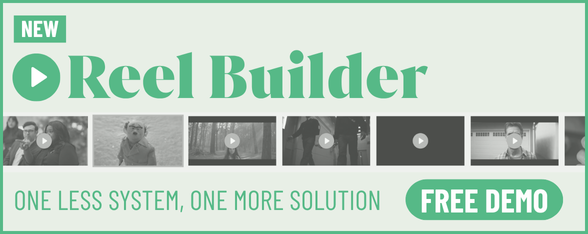
The High-Risk Adventures of an Aerial Cinematographer

As part of the ‘Portraits of CREATVAsia’s Associates’ series, Othello Khanh, managing director of The CREATV Company speaks with director of photography, Laurie K. Gilbert, who has decades of award-winning experience in shooting global motion picture material for cinema and television, and corporate communications production.
Operating from his residential bases in New Zealand, Australia, Hong Kong, Singapore and Malaysia, Laurie has an incredibly diverse portfolio, from Hollywood films and high-end leisure to city icons (MBS Singapore, Petronas Towers KL), national defense and some of the world’s most captivating natural landscapes. His shoots have seen him fly in all manner of aircraft, shooting air-to-air, air-to-land and air-to-sea.
Othello reflects on getting to know Laurie and interviews him on shooting and testing aerial photography for the likes of Walt Disney and ‘Mission: Impossible’, navigating high-risk environments, and taking Helicopter Underwater Escape Training six times.
I have known Laurie for over 20 years, starting with jobs going back to the early aughts. We’ve worked on many oil and gas, and search and rescue offshore projects. He was one of the few in the industry with a clear explanation for the safety protocol of such high-risk filming and also bringing cost-effective technical solutions to the early stabilisers.
In addition to being a technical wizard – able to get coverage of fast moving objects with pinpoint accuracy as he is himself in motion – Laurie is a true storyteller, who captures the nuances of the human spirit around the globe. He is warm, giving and has an eagle eye. It’s a pleasure to introduce him here on LBB.
CREATV> What first drew you to the world of cinematography – and specifically aerial photography?
Laurie> I was attracted to a career in aerial cinematography because of the potential for adventure!
In 1969 I was studying fine art at the Royal Town of Sutton Coldfield in England and I came across a copy of ‘The American Cinematographer’ detailing the adventurous challenges of filming ‘On Her Majesty's Secret Service’. In the back of the magazine was an advertisement for The London Film School and when my application was eventually accepted, Sutton Coldfield gave me a Royal Scholarship to finance my study.
The aerial expertise evolved as I concentrated on the pioneer, global television coverage of offshore sailing television (Americas Cup, Olympic Regattas, Kenwood Cup, TRANSPAC, Key West Regatta, Rolex Maxi Series) and my application of the newly invented Schwem Gyro lens to this challenging sport.
As a result, Roy E Disney and his associates at CSTV in Hawaii hired me regularly between 1990 – 2007 to shoot helicopter aerial coverage of sailing in the USA and Europe, culminating in aerial cinematography for The Walt Disney Pictures film, ‘Morning Light’.

CREATV> You are accredited in Hollywood as an aerial marine expert in Asia. How did that specialisation evolve?
Laurie> In 1989, Australia experienced a minor recession and rather than lose the professional momentum I had gained over 15 years as a motion picture DOP, I ventured up to Hong Kong to see if my skills travelled. Although I had shot some aerials previously, when I arrived in Hong Kong it was as a conventional commercial and documentary cameraman but with recent Americas Cup, sailing cinematography experience.
Relocating opened up the markets of Southeast Asia, especially mainland China, and over the next decade I was to shoot more than 100 television documentaries and business films in the country – even a Hong Kong-financed feature film.
Two of the most important documentaries I made during that time were for the UNHCR who commissioned a series of films on the culture of north and south Vietnam which they planned to show nightly in the Hong Kong refugee camps.
These films were specifically shot to try and persuade the camp residents to accept a generous payment and return to their homeland before June 30th 1997 (deadline of the British handover of Hong Kong to China), when the camps had to be empty.
Thus began a professional love affair with cinematography in Southeast Asia, especially in Vietnam.
CREATV> You were one of the very first cameramen to shoot professional helicopter aerials in the new, emerging Vietnam. How did that happen and what were the challenges?
Laurie> When the World Wide Web was invented in the mid '90s, I built a web page including both limited aerial but extensive offshore marine experience. CREATV found me via this site because they had a client with significant exploration assets offshore from the city of Vung Tau and they required aerial imagery of the jacket and topside installation for the Nam Con Son pipeline infrastructure linked to the Ty Vay export facility and ultimately to the Phu My 3 power plant.
The production company had full access to an available aircraft in the helicopter offshore transit fleet but faced the enormous challenges of shooting stable, long lens, aerial imagery of the exploration facilities 400 kms offshore.
In 1986 as the primary offshore cameraman of the XXVI Challenger Series for the America’s Cup in Australia, I’d used a new gyro stabilised lens for the traditional Betacam camera, called a Schwem FP-1. Despite ranging from 60-300mm in focal length, the internal gyros allowed it to produce rock stable, hand-held imagery both in rough seas and from the air.
By 1990 I had had four years intensive experience with the operation of this lens worldwide and so this then was the simple cinematic solution I proposed to CREATV to solve their offshore helicopter imagery challenges – and indeed it worked very well.
CREATV> You’ve filmed across nearly every major continent. How does cultural context influence the way you tell visual stories?
Laurie> In all of my global aerial projects, the script and the director dictate how the final story is told visually and we try to use the key attributes of the location below us to complement the storytelling. I rarely work with specialised aerial directors – but instead communicate with the pilot directly and use my experience to control the flight approach to the target that takes the direction of the light, speed, height, angle and focal length to tell the best story onto the film director’s monitor as he sits beside me in the aircraft.
Most of the major challenges in different countries come from external factors. During the shooting of the film ‘Street Fighter’, for example, we had to be extremely careful not to fly anywhere close to the palace of the King of Thailand in central Bangkok. Daily challenges include flight permissions, language, cultural sensitivities and sometimes having to make do or improvise when local support equipment isn’t necessarily state of the art.
During one prestigious project in China, we had unlimited access to Chinese military helicopters as camperships but the China Airforce pilots only spoke Mandarin. The solution was to fly English-speaking Chinese pilots in from Hong Kong to act as our in-flight interpreters.
CREATV> How has your aerial cinematography work in Asia evolved over time?
Laurie> As the gyro stabilisation technology evolved to produce Cineflex, GSS and Shotover external helicopter camera gimbals, so these systems were available for application on many of my global helicopter projects, when budget allowed.
The award winning, global aerial television coverage of both the Beijing and the London Olympic Sailing Regattas were shot by a specialist team, including myself with a range of these specialist, stabilised cameras.
Likewise, here in Malaysia where I now live and operate from, we provide local support for the helicopter aerial cinematography teams shooting the Singapore Grand Prix and SailGP and the Formula E Grand Prix in Malaysia. We also provide aerial flight and safety planning plus Shotover operating services if required, for European companies planning prestigious television productions in Malaysia.
Complementary to our aerial cinematography, we currently provide helicopter air-to-air, photographic stills services to both Airbus helicopters and Leonardo helicopters for their Asia branding requirements.
We have also developed an extensive European maritime client base for our helicopter stills photography and we travel hundreds of miles into the Malacca, Sunda and Bali Straits on advertising imagery projects for them. On these expeditions we track and rendezvous with clients’ ships, photographing them in locations like Pulau Krakatau (Krakatoa Island) between Java and Sumatra, well beyond the operational range of current, commercial, photographic drones.

CREATV> What was it like shooting Malaysia test aerials for ‘Mission: Impossible – Rogue Nation’? Any behind the scenes stories you can share?
Laurie> In 2014 Skydance Media was shooting ‘Mission: Impossible – Rogue Nation’, the fifth film in the very successful franchise. The film opens with the character Luther, played by Ving Rhames, communicating with the MI team supposedly from the top of the Menara Kuala Lumpur telecommunications tower in Malaysia. During pre-production, the producers needed to see what the tower looked like and how it was integrated into the city skyline of Kuala Lumpur, especially in relation to the iconic Petronas Twin Towers.
So at their request, we mounted a RED camera onto locally available Continental Magnum Helicopter Mount and installed it into the AS355 camera ship operated by Malaysian company, Solaire Helicopters. Captain Cliff Fournier and I then spent more than an hour shooting Kenyon K8 stabilised test aerials of the tower and its environs which were then sent through to Hollywood.
CREATV> In such high-risk environments – over oil rigs, near warships, or inside active volcano zones – how do you balance artistry and safety?
Laurie> Our job is to shoot the most dynamic aerial imagery for the screen without ever risking the lives of the production crew or members of the public. Dynamic helicopter aerial cinematography may look dangerous but the truth is that we always operate within the parameters of our specialist experience and especially within the very strict capabilities of the aircraft.
I always fly with the most experienced pilots available and once we are in the air, the pilots are 100% in control of exactly how and where the aircraft operates. As an aerial director I can make requests for altitude and positioning but the pilot ALWAYS has the ultimate authority to say ‘no’.
I do believe the quality and resolution of current cameras and gyro stabilised, long lens systems make this process a lot safer than the film-based techniques we may have used 30 years ago. Having said that, things can still go wrong and we must be fully trained and hopefully capable of surviving mishaps, especially offshore.
I have renewed my HUET (Helicopter Underwater Escape Training) six times now – meaning I have performed 48 escapes from mock helicopters in a supervised, water ditching scenario. My pilots and I wear small, personal EPIRB transmitters which will broadcast our location to satellite-based rescue services globally if we activate them after ditching. I also carry a heliograph solar signalling mirror in my flight suit which I have actively used twice to attract the attention of potential rescuers.
CREATV> Are there any special preparations you need before you fly offshore?
Laurie> There are strict, international safety rules for everyone flying in a helicopter and landing on an offshore exploration platform and they must receive HUET in case something goes wrong on the flight. In most highly developed, offshore industry cities like Aberdeen this training is done in a very sophisticated and very expensive, mock helicopter cabin in a purpose-built swimming pool. The cabin is supported by an ingenious rig which inverts it underwater and the trainees must then escape through doors and windows and rise to the surface without panic, multiple times.
At the time of our proposed offshore expedition, the industry support facilities in the city of Vung Tau were not as developed as Aberdeen, but what the industry lacked in sophistication, it more than made up for in imagination. This is why five members of CREATV, including myself, were required to take a classic, vintage Russian hydrofoil from HCMC to the Vung Tau and then proceed to the guest swimming pool of the Rex Hotel, to experience HUET, Vietnam style.
At one end of the pool, divers controlled the inversion of a mini, aluminum fabricated helicopter cockpit and monitored how well CREATV staff survived underwater – at the other end of the pool, a traditional Vietnamese wedding was taking place with invited guests unable to take their eyes off the aquatic theatrics at the other side of the pool.
After multiple immersions and multiple escapes, all crew members passed every test and received legal accreditation to fly 400 kms in a helicopter to an offshore exploration rig.
CREATV> What is the most extreme aerial project you have been involved with in Asia?
Laurie> In 2000 the Turkish Airforce celebrated a major anniversary as the second oldest Airforce in the world and Flight Command in Ankara wanted a dramatised film made of their legendary aerobatic team, the Turkish Stars.
They invited me to travel to Konya, in Anatolia, to shoot supersonic, in-cockpit, air-to-air imagery of their dramatic formation flying. This was decades before GoPro or small broadcast cameras with electronic media cards and so I had to figure out how to mount and operate Canon Mini DV tape cameras, in-cockpit whilst pulling high G forces during extreme aerial manoeuvres.
Heavy steel camera mounts were designed, fabricated and installed inside the aircraft to look at either the pilot or the adjacent aircraft formation. Then every day for several weeks the pilots and I flew multiple cameras, on daily sorties in multiple formations, ultimately generating 60 hours of dynamic, supersonic, air-to-air video imagery.
After completing the aerial sequences of the film, the production crew travelled to the city of Istanbul to complete the drama content of the film. All this material was eventually used for a series of different Türk Hava Kuvvetler branding films and two of these films won cinematography craft awards in New York and in various prestigious film festivals throughout Asia Pacific.
CREATV> Is there a project, location, or subject you’ve always dreamed of filming but haven’t yet?
Laurie> As Shotover, GSS and Cineflex have evolved to the point where they can now easily stabilise a 1000mm motion picture lens, so I think I would like to return to the Middle East and reshoot the high speed action of the Abu Dhabi Desert Challenge with this equipment from a dedicated campership, rather than handholding a Betacam and 300mm Schwem lens in the open doorway of the medical rescue helicopter.















